Salamanders Can Grow Back Amputated Limbs—Why Can’t We?
Update: 2019-12-13
Description
Ken Poss, PhD, James B. Duke Distinguished Professor of Cell Biology and Director of the Regeneration Next Initiative, explains how salamanders can regenerate limbs and discusses what implications that has for the future of human limb regeneration.
Transcript
Lindsay Key
Welcome to Headscratchers, a mini-cast from the Duke University School of Medicine. We ask Duke experts to help us understand the questions in science that have us scratching our heads. Today we're speaking with Dr. Ken Poss, an expert in human regeneration. We asked him: Dr. Poss, I've heard about how a salamanders’ limbs can regrow after being amputated. How do they do that? And why can't human limbs do the same thing?
Dr. Poss
When a mammalian species loses an arm? Well, first, there's a lot of bleeding. There's clotting, there's inflammation. And ultimately what happens is, it forms a scar to limit the damage and that limb will form a stump that can be adequate for the rest of that animal's life. Now, salamanders, it's different. After an amputation, there's bleeding. There's clots. There's inflammation -- those first things happen.
But then something special happens, something that's really important for regeneration. And that is the formation of a structure called the blastema. And a blastema is a unique structure in biology, even kind of hard to describe. Many have considered this similar to a tumor. It's a mass of cells that continues to grow, and it forms kind of a ball of proliferative, or dividing, cells. But in many other ways, it's nothing like a tumor, because that blastema has all of the information needed to recreate that limb. A new limb essentially sprouts from the blastema; really fascinating.
We are on our way to understanding how to stimulate something similar in, say, an injured human limb. I think something people may not realize is that we humans are actually really good at regenerating certain things. So while we can't regenerate something like an amputated limb, we can regenerate our blood, our liver; our intestinal lining is continually regenerating. I think humans have the general machinery where it's possible, with the right manipulations -- we will be able to make human limbs regenerate at some point in the next decade, two decades, 50 years. It's going to be very exciting. We really might be able to change things.
Lindsay Key:
Thanks for listening. This podcast was produced by the Duke University School of Medicine music by Blue Dot Sessions. Visit us online at headscratcherspodcast.duke.edu, or subscribe on iTunes or SoundCloud. If you like us, leave us a review.
Medical Disclaimer & Terms of use at https://bit.ly/2LrjWdh
Transcript
Lindsay Key
Welcome to Headscratchers, a mini-cast from the Duke University School of Medicine. We ask Duke experts to help us understand the questions in science that have us scratching our heads. Today we're speaking with Dr. Ken Poss, an expert in human regeneration. We asked him: Dr. Poss, I've heard about how a salamanders’ limbs can regrow after being amputated. How do they do that? And why can't human limbs do the same thing?
Dr. Poss
When a mammalian species loses an arm? Well, first, there's a lot of bleeding. There's clotting, there's inflammation. And ultimately what happens is, it forms a scar to limit the damage and that limb will form a stump that can be adequate for the rest of that animal's life. Now, salamanders, it's different. After an amputation, there's bleeding. There's clots. There's inflammation -- those first things happen.
But then something special happens, something that's really important for regeneration. And that is the formation of a structure called the blastema. And a blastema is a unique structure in biology, even kind of hard to describe. Many have considered this similar to a tumor. It's a mass of cells that continues to grow, and it forms kind of a ball of proliferative, or dividing, cells. But in many other ways, it's nothing like a tumor, because that blastema has all of the information needed to recreate that limb. A new limb essentially sprouts from the blastema; really fascinating.
We are on our way to understanding how to stimulate something similar in, say, an injured human limb. I think something people may not realize is that we humans are actually really good at regenerating certain things. So while we can't regenerate something like an amputated limb, we can regenerate our blood, our liver; our intestinal lining is continually regenerating. I think humans have the general machinery where it's possible, with the right manipulations -- we will be able to make human limbs regenerate at some point in the next decade, two decades, 50 years. It's going to be very exciting. We really might be able to change things.
Lindsay Key:
Thanks for listening. This podcast was produced by the Duke University School of Medicine music by Blue Dot Sessions. Visit us online at headscratcherspodcast.duke.edu, or subscribe on iTunes or SoundCloud. If you like us, leave us a review.
Medical Disclaimer & Terms of use at https://bit.ly/2LrjWdh
Comments
In Channel














